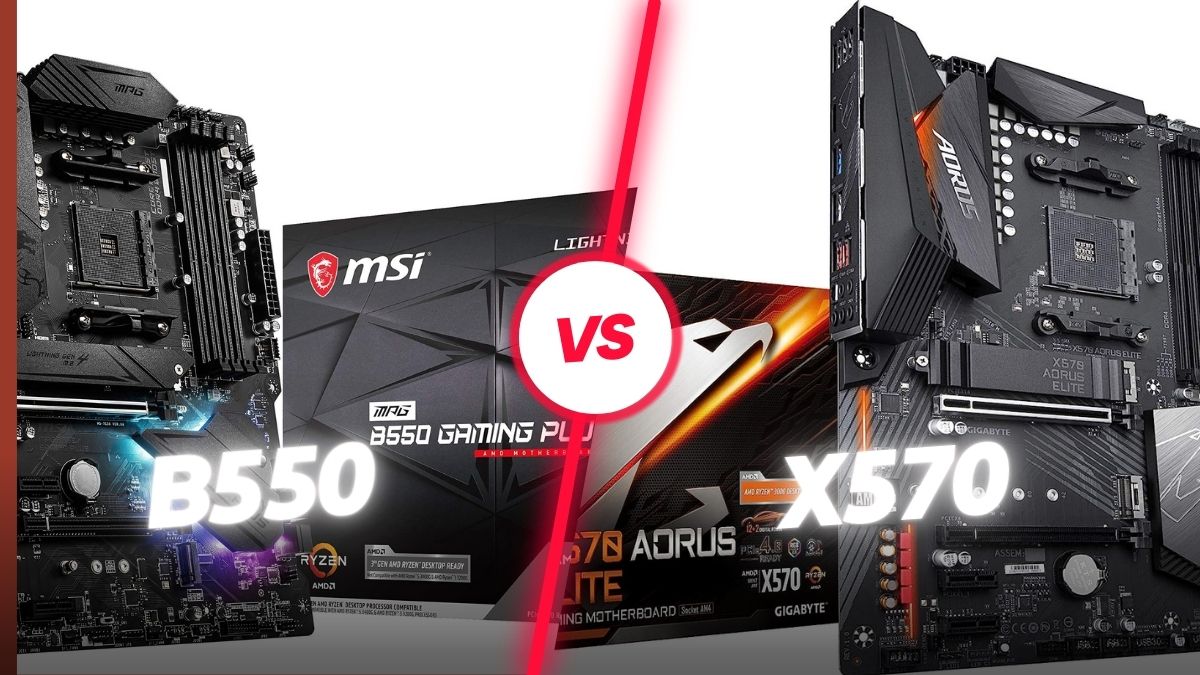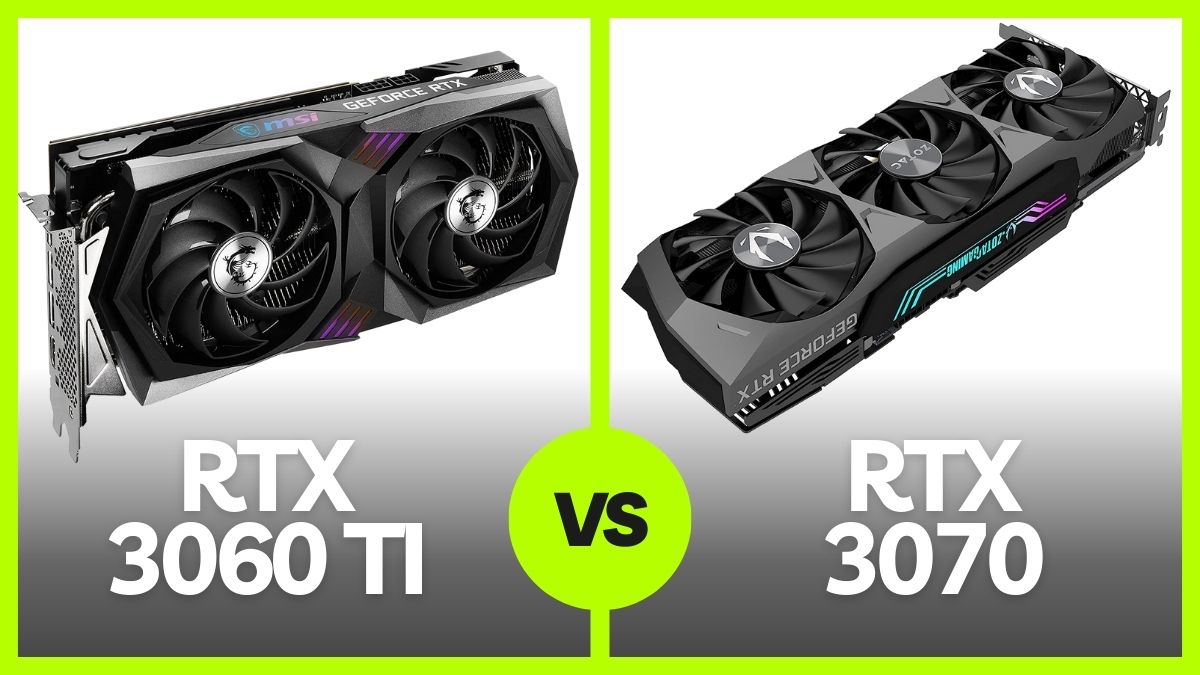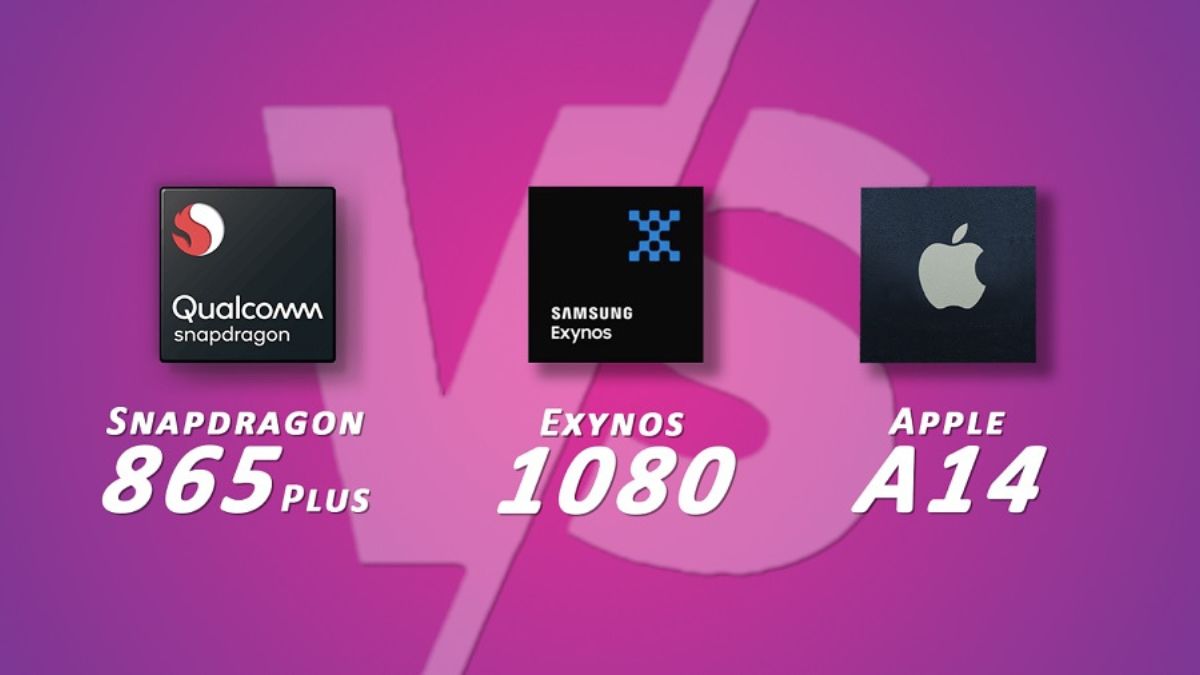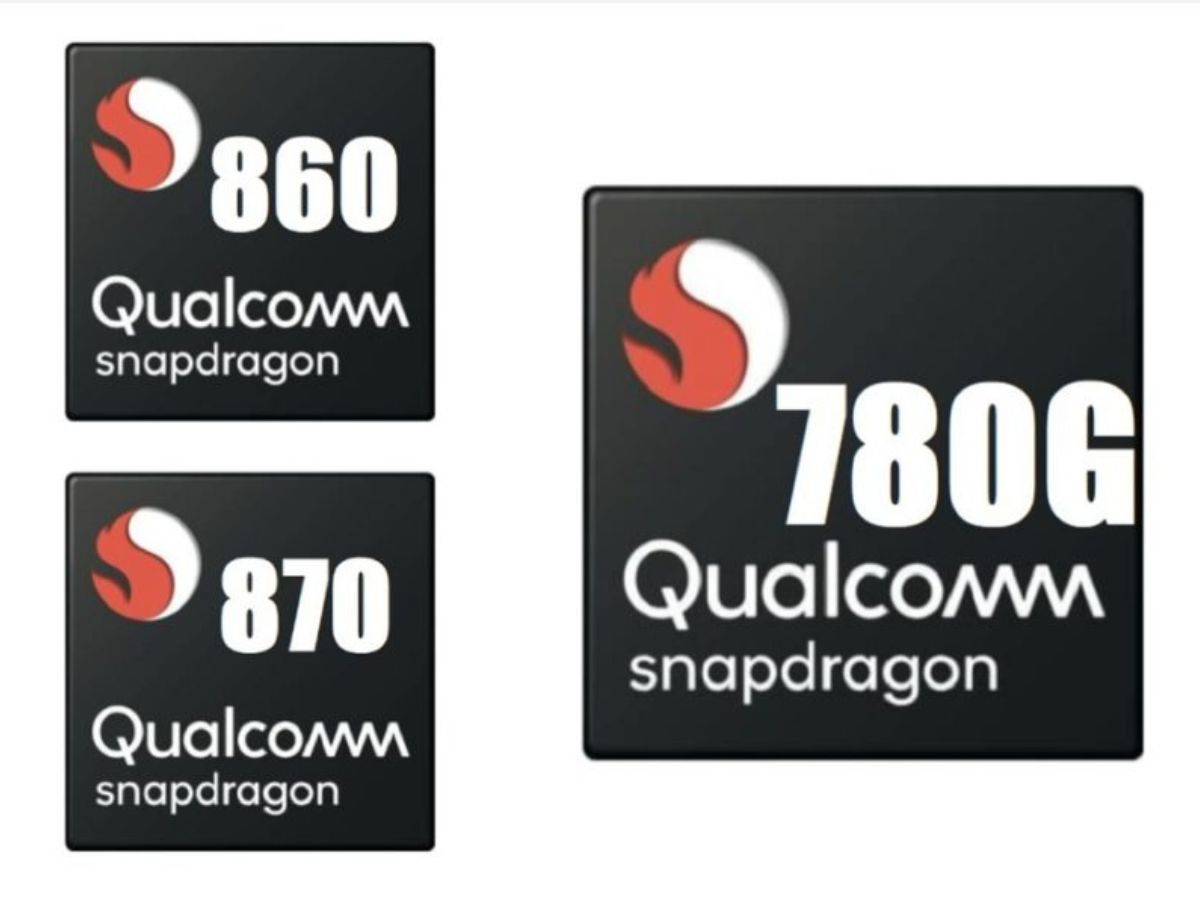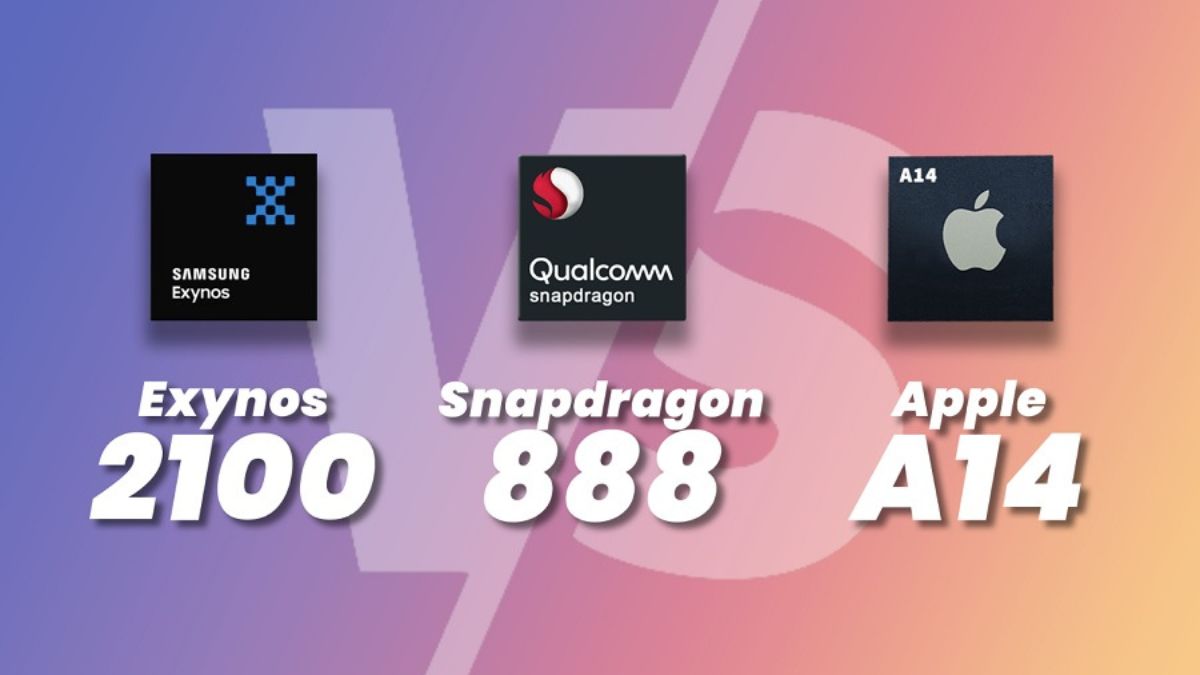
In the current flagship smartphone market, the best Android and iOS smartphones use either the Exynos 2100, Snapdragon 888, or the Apple A14 Bionic SoCs. A14 Bionic is available in Apple’s iPhone 12 series and iPad, and the Exynos 2100 / Snapdragon 888 in the newly launched Samsung Galaxy S21 series smartphones.
Other smartphone OEMs like Xiaomi, Realme, Oppo, etc. emphasize preferring SD 888 over the Samsung Exynos 2100. Xiaomi Mi 11 was the first commercially available Snapdragon 888-powered smartphone in the world. Samsung launched the Exynos 2100 on 12th February, and now the list of flagship mobile processors of 2021 is finally completed. The Exynos 2100, Apple A14 Bionic, and the Snapdragon 888 SoC will rule the flagship smartphones of 2021.
These three SoCs of 2021 are really very promising in terms of performance and support for the latest technologies. For instance, all three SoCs are made over the latest 5nm EUV fabrication. The latest manufacturing technologies from Samsung and TSMC promise a huge improvement in the chips’ efficiency packed in a smaller package due to the possibility of fitting more transistors in that same area.
However, there are still many differences in the features and the specifications that these SoCs provide. Let’s talk about them by comparing these mobile chipsets side by side.
Exynos 2100 vs. Snapdragon 888 vs. A14 Bionic
| Exynos 2100 | Snapdragon 888 | Apple A14 Bionic | |
|---|---|---|---|
| Launched | January 12, 2021 | December 2, 2020 | September 15, 2020 |
| CPU | 1x Cortex-X1 core @2.9GHz 3x Cortex-A78 cores @2.8GHz 4x Cortex-A55 cores @ 2.2GHz | 1x Cortex-X1 @ 2.84GHz 3x Cortex-A78 @ 2.42GHz 4x Cortex-A55 @ 1.8GHz | 2x Performance (Firestorm) cores @ 3.1GHz 4x Efficiency (Icestorm) cores @1.8GHz |
| GPU | Mali-G78 MP14 | Adreno 660 | Apple-designed four-core GPU |
| Process | 5nm | 5nm | 5nm |
| Display | 4K @120Hz QHD+ @144Hz HDR10+ | 4K @60Hz QHD+ @144Hz FHD+ @144Hz HDR10+ | HDR10+ |
| Camera | Single: 200MP Dual: 32MP+32MP | Single: 200MP Dual: 64MP+64MP Triple: 28MP+28MP+28MP | N/A |
| RAM | LPDDR5 | LPDDR5 | LPDDR4x |
| Modem | Download: 7.35 Gbps Upload: 3.67 Gbps | Snapdragon X60 Download: 7.5 Gbps Upload: 3 Gbps | N/a |
| Antutu | 6,79,579 (approx.) | 7,18,858 (approx.) | 5,72,533 (approx.) |
| Geekbench | Single-Core: 1111 Multi-Core: 3848 | Single-Core: 1127 Multi-Core: 3728 | Single-Core: 1583 Multi-Core: 4158 |
CPU Cores & Performance
This is where things get promising for Samsung. We have seen a marginal performance difference b/w the Snapdragon and Exynos flagship chips, and the main reason was considered the use of Samsung’s self-made Mongoose cores in its chips. But this time, Samsung has ditched the Mongoose cores and has decided to go fully ARM-relied on the CPU architectures.
Samsung and Qualcomm are now sharing a very similar CPU design in which 8 cores are divided in a 1+3+4 manner. The one core available in both these SoCs is the Cortex-X1 core, set to perform at the highest speeds. Following that, there are 3 Cortex-A78 cores and 4 Cortex-A55 efficiency cores.
Qualcomm never uses ARM’s cores as it is. It customizes them a bit and presents them under the Kryo CPU branding. In Snapdragon 888 SoC, the Kryo 680 CPU comprises the aforementioned cores in a customized manner. The customization is definitely making the CPU performance better, but Samsung’s Exynos 2100 has higher clock frequencies than the Snapdragon 888’s CPU. This may lead to a really very similar CPU performance in both the SoCs.
Talking about the Apple A14 Bionic, Apple has gone with the same 6-core CPU, among which there are 2 high-performing Firestorm cores, and 4 efficient Icestorm cores clocked at 3.1GHz and 1.8GHz, respectively. These are Apple’s in-house custom cores based on ARM’s design, but there is no specific information about these cores, just like every year.
Fabrication
It has already told about the manufacturing processes of these smartphones. These smartphone chips are built on the 5nm processes as this is what the new 2021 year demands. Samsung’s 5nm fabrication has been used in both Samsung’s own Exynos 2100 and Qualcomm’s Snapdragon 888 SoC.
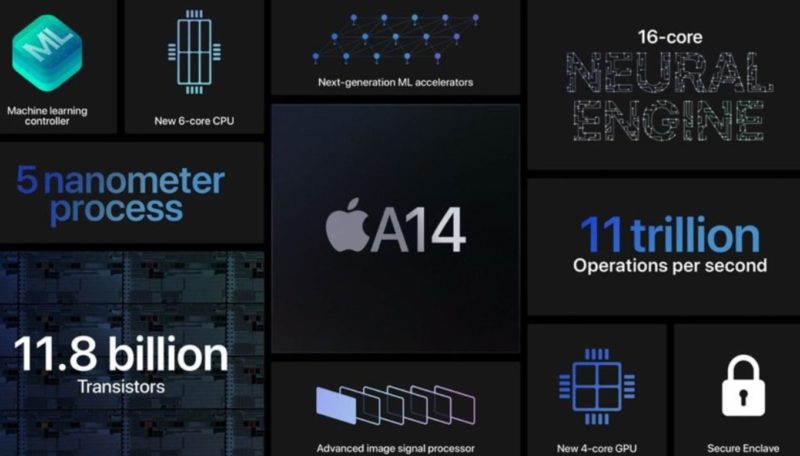
However, Apple’s A14 Bionic chip has been fabbed over the TSMC’s 5nm process. Even though the companies are different, the manufacturing processes can’t be different from each other, and one can consider the fabrication of these SoC to be the same.
GPU & Graphics performance
This department has a completely separate scenario in terms of on-paper specifications. All three SoCs have different GPUs in them. But there are some bold performance claims made by the companies in terms of GPU performance.
Starting from Samsung, the Exynos 2100 has the Mali G78 MP14 GPU, which is, as its name suggests, is a 14-core GPU from ARM. Samsung is claiming a 40% GPU performance boost over Exynos 990’s Mali G77 MP11 GPU. This is definitely a pretty huge leap in the GPU performance from the last generation.
The snapdragon 888 is on the battlefield with the new Adreno 660 and claims a 35% GPU performance boost over the last-gen. The Adreno 650 GPU of the Snapdragon 865 was one of the best-performing mobile GPUs, and an extra 35% performance boost brings the Snapdragon 888 to be a nice GPU performer.
Coming to Apple, then the company has improved a lot in terms of GPU performance this year. Apple has its own home-grown 4-core GPU, which has been proven to be 8-10% better than the previous Apple A13 Bionic. This is definitely not an impressive boost in performance if we compare it with the other SoCs.
This small improvement in the GPU performance from Apple has given the Android chips the chance to match up the performance. And we can expect the Snapdragon 888 and Apple A14 Bionic performance gap to be the minimum than ever before. The Exynos 2100 and Snapdragon 888 GPU performance gap will also be minimal, and the real-life experience will be just the same in terms of gaming and other GPU-intensive tasks.
Artificial Intelligence & Machine Learning
The chip makers are also emphasizing a lot on the AI capabilities of their chips. And in this field, the Exynos and Snapdragon seem to have a neck-to-neck competition. Followed by the Apple A14 Bionic’s AI performance claims, which are definitely better than the previous-gen but are not enough for the market.
The Samsung Exynos 2100 comes with the company’s new 3-core AI processing unit, based on which Samsung is claiming the chips capable of reaching 26 TOPS of AI performance. Qualcomm has also made the same AI speed claims, and the SD 888 is also able to reach 26 TOPS. SD 888 has a new Hexagon 780 Digital Signal Processor.
Coming to Apple, the A14 Bionic chips boast an NPU, which is really very high on the number of cores it has. Specifically, it is a 16-core NPU design embedded inside the A14 Bionic chip, but Apple claims to make the chips reach just 11 TOPS of AI speed. This speed is even less than the SD 865’s 15 TOPS of AI speed.
It will be wrong to judge these chips’ AI performance just based on the TOPS value, and we should wait for the real-life performance results.
ISP & Camera
Qualcomm has gone with a triple ISP for the first time, simultaneously processing the image signal from three different sensors. The Exynos 2100 is further one step ahead as the processor can process data from 4 cameras instead of 3.
The rest of the specs are pretty similar. Both the chips support up to 200MP single camera or up to 6 different camera sensors. These chips’ video recording capabilities enable you to shoot 4k @ 120fps or 8k up to 30fps. The decoding of 8k videos ranges to 60 fps in the Exynos 2100, and just 30 fps in the SD 888.
Talking about the Apple A14 Bionic, nobody can’t say anything about the camera specifications of the A1 Bionic as the company doesn’t reveal anything. But still, iPhones are one of the best camera smartphones in the industry just by using a 12MP main camera sensor, plus video recording of up to 4k at 60fps has been seen maximum on Apple devices.
5G connectivity
Only the Apple A14 Bionic comes with the exception of not having an integrated 5G modem, whereas the rest of the chips provides an integrated 5G solution to the users. The current Apple iPhones are using the Qualcomm X55 5G mode, the 2nd gen 5G modem from Qualcomm, and 5G speeds of up to 7Gbps and 3GBps in downlink and uplink.
The Snapdragon 888 comes with the X60 5G modem, which is the 3rd gen 5G modem from the company and has a bit better 5G connectivity than the X55 5G modem. Samsung has its own 5G modem, which is similar to the X60 5G modem.
All the modems support mmWave and Sub-6GHz 5G connectivity. However, the X55 modem being an old one can receive/transmit both types of 5G signals simultaneously, whereas the Exynos and Snapdragon modems can do so.
Talking about the speeds of these integrated modems, these are pretty similar and are as follows:
- mmWave 5G: 7.35Gbps (Exynos 2100), 7.5Gbps (SD 888)
- Sub-6 GHz: .1Gbps (Exynos 2100), 7.5Gbps (SD 888)
- 4G: 3Gbps (Exynos 2100), 3Gbps (SD 888)
The 5G connectivity in the Apple A14 Bionic is slightly behind compared to the rival Android chips. And 5G connectivity is one of the main concerns and an important segment, Apple A14 Bionic can’t be said as a future-proof SoC in terms of connectivity.
AnTuTu-Geekbench Benchmarks
AnTuTu Benchmark Scores
The Samsung Exynos 2100 has been seen with an AnTuTu score of 6,79,579, whereas the Snapdragon 888 scored 7,18,858. The scores are clearly saying that the Snapdragon 888 has a better performance.
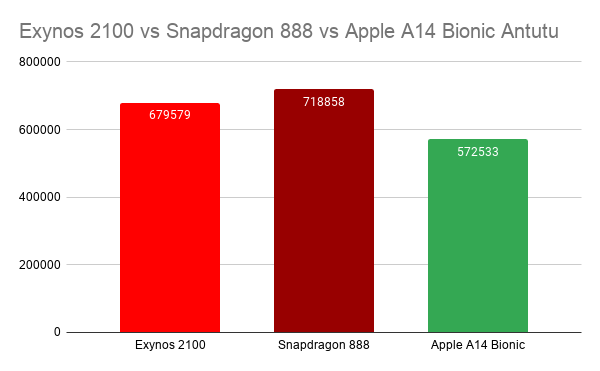
Coming to the Apple A14 Bionic, the chip is low on AnTuTu benchmarks and has been seen the AnTuTu benchmark with a score of 5,72,533.
Geekbench Benchmark Scores
The Geekbench benchmarks are showing a bit different story. The Geekbench Single Core and Multi-Core scores of the Exynos 2100 are 1,111 and 3,848, respectively. However, the Snapdragon 888’s Single and Multi-Core scores are 1127 and 3728 points. The Single-core performance of both the SoCs is very similar, but the Multi-core performance is slightly better in the Exynos 2100.
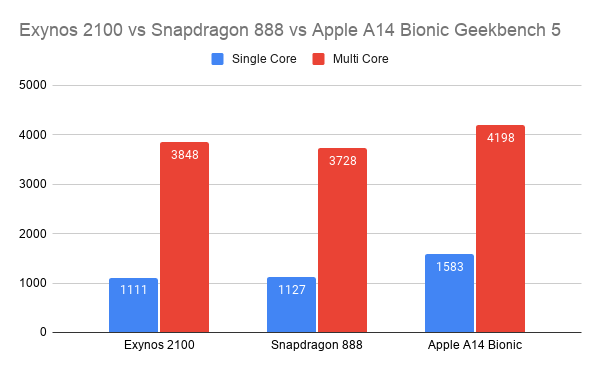
The Geekbench benchmarks of the Apple A14 Bionic are the highest compared to the other two. It has Single and Multi-Core scores of 1583 and 4198, respectively, which are pretty high.
Conclusion – Which One is Better?
This comparison leaves us because the historic performance gap that existed b/w Apple and Android devices are going to be the lowest ever existed as the Snapdragon 888 and Exynos 2100 have come up with serious upgrades. The Apple chips will still lead the performance chart, but the margin by which the A14 Bionic will lead is going to be pretty negligible.
Also, the 5G connectivity is something where Apple doesn’t have a good grip, and if your concerns are about a decently future-proof 5G connectivity, the Apple A14 Bionic is not the one for you. Instead, you should look at the Snapdragon 888, followed by the Exynos 2100.
There is no doubt that mobile processors are on all new heights of delivering top-notch performance. Even after being a bit better or behind in some aspects of each other, the SoCs are capable enough to provide extreme performance on your compact smartphone. From a normal user’s perspective, none of the SoCs can ever disappoint you at any stage of performance and are capable of providing a beast-like performance.



